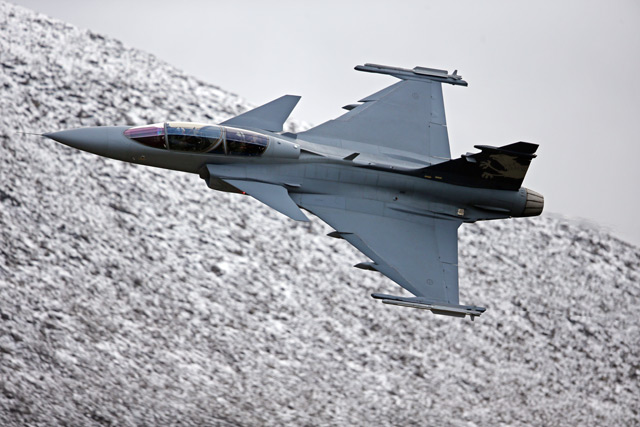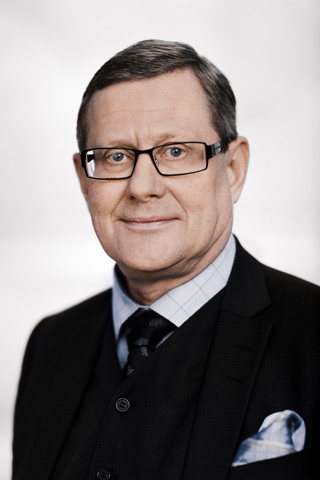For a European defence and security company to be talking about switching focus from its domestic customer to export markets is hardly rare these days. For Sweden's Saab, however, the transition from national provider to export powerhouse has largely taken place already.
In the early 2000s, the company was gathering about 70% of its revenues from the Swedish government and only 30% from overseas sales. Today, that ratio has been reversed, partly driven by a decline in Swedish defence spending, which began almost a decade before other fiscally squeezed European nations began to slash budgets.
But the company - celebrating its 75th anniversary this year - has also successfully cultivated foreign business, helped by a series of acquisitions and deals for its flagship Gripen single-engined fighter with the Czech Republic, Hungary, South Africa, Thailand and, most recently, Switzerland, as well as a range of other systems and services.
EXPORT ORIENTATED
Saab has reinforced its new export-oriented approach with a company structure split into six sales-focused divisions, covering Europe and the Middle East, the Americas, sub-Saharan Africa, India, Asia-Pacific and the Nordic region. "It's another step in our strategy to continue to grow," says Tomas Samuelsson, newly appointed to run the largest of these "market areas", Europe and the Middle East.
Samuelsson - formerly head of Saab's missiles business - will be based in London, where the company opened an office in 2011. Saab has about 200 staff in the UK, with locations also in Fareham, Hampshire and Westbury, Wiltshire.
 |
|---|
Armasuisse Switzerland has selected the latest-generation Gripen E as the preferred candidate to replace its Northrop Grumman F-5s |
In addition to its own industrial footprint, Saab has a "long history of co-operation" with other manufacturers in the UK, says managing director Peter Hultin, with former programme partner BAE Systems and Selex Galileo in Edinburgh providing about 30% of Gripen content.
Last year, Saab recruited a 10-strong design team in the UK to deliver proposals for a naval version of its fighter, dubbed the Sea Gripen. The UK's heritage in "maritime jet engineering expertise" helped in the hunt for those with the necessary skills, says Samuelsson. That study was completed in October and is being reviewed in Sweden with a view to offering the variant to potential customers.
Samuelsson adds that Saab is "looking at further opportunities" both in terms of partnering and acquisitions in the UK. "We are certainly keeping our eyes open," he says. Saab has recently been dipping into its acquisition war chest elsewhere in Europe, buying an air traffic management technology developer in the Netherlands and, in October, Medav, a German specialist in signals, electronic and communications intelligence.
Its industrial and acquisition strategy has also been driven by Gripen sales and campaigns. The company has a facility in the Czech Republic, one of two European export customers, along with Hungary. In South Africa - where Saab delivered the last four of 26 Gripen C/Ds earlier this year - it also intends to set up a training centre with the South African Air Force, targeting pilots from nations which fly the aircraft.
SWISS DECISION
Production of the fighter in Switzerland is also on the cards following its decision this year to become the latest Gripen export customer. Bern has selected the latest generation of the fighter, the Gripen E, as the preferred candidate to replace its Northrop F-5s, earmarking 22 orders. "We are working in Switzerland to find partners," says Samuelsson. Croatia could be next, with Saab - backed by the Swedish defence export organisation - submitting a bid to supply the new NATO member with eight Gripen C/Ds in place of its ageing Mikoyan MiG-21s.
While the Gripen is Saab's only airborne platform, company activities cover a wide range of defence and air, land, naval and civil security applications. Split into five business divisions - aeronautics, dynamics, electronic defence systems, security and defence solutions, and support and services - the privately owned business employs 13,000 and is ranked 33rd in the Flight International Aerospace Top 100, with a turnover in 2011 of $3.19 billion and profits of $69 million.
 |
|---|
Saab Samuelsson: eyeing acquisitions in the UK |
One area the Swedish manufacturer will not be returning to, however, is civil aircraft. After more than five decades in the business, Saab stopped making the 340 turboprop and its successor, the 2000, in the late 1990s. And - while it retains a leasing portfolio of about 60 aircraft worth slightly less than $400 million on its books - it has firmly refuted reports it has been studying a return to turboprop manufacturing. Instead, it plans to divest its remaining leasing fleet by 2015.
Saab was founded in 1937 to supply Stockholm with armaments and aircraft as European conflict dawned, although Sweden remained neutral during the Second World War.
Since then, the company has forged a reputation for innovation, developing products from missiles and aircraft to cars - a business it partly spun off in 1990 into a joint venture with General Motors - consolidating Sweden's defence industry in the process through a series of acquisitions such as Ericsson Microwave Systems and Celsius.
Samuelsson maintains that Saab's experience of delivering products on time to a domestic customer operating on a tight budget makes it an ideal supplier or partner for straitened times, with governments throughout the world putting more emphasis on value for money. "We are all about high-tech but affordable solutions when there is pressure on the financial side. We have been doing this in Sweden for the past 10 years," he says.
While Saab lacks the geopolitical support of a big-nation government in negotiating export deals for the Gripen in particular - unlike rivals Eurofighter and Dassault- Samuelsson says this is not always a drawback. "Yes, sometimes that sort of backing and influence is hard to compete against, but our edge is that we are smaller and more agile, and Sweden is highly regarded as a high-tech nation. We are all about flexible solutions and partnerships," he says. "It means we can often be the more independent choice."
Source: Flight International
















